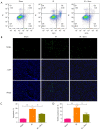Sevoflurane attenuates hepatic ischemia reperfusion injury by the miR-122/Nrf2 pathway
- PMID: 35433991
- PMCID: PMC9011315
- DOI: 10.21037/atm-22-115
Sevoflurane attenuates hepatic ischemia reperfusion injury by the miR-122/Nrf2 pathway
Abstract
Background: Sevoflurane can protect organs from ischemia-reperfusion (IR) injury, but the mechanism is still unclear. MicroRNA-122 (miR-122) is a liver-specific microRNA (miRNA) and regulates liver function. Therefore, this study aims to elucidate the relationship between the protective effect of sevoflurane and miR-122 in liver IR injury.
Methods: Wistar rats were divided into the following groups: sham, IR, IR + sevoflurane, IR + miR-122 antagomir, and IR + miR-122 antagomir + sevoflurane. Hematoxylin and eosin (H&E) staining and Suzuki score were used to evaluate the pathological damage of the liver. The levels of aspartate aminotransferase (AST), alanine aminotransferase (ALT), lactate dehydrogenase (LDH), tumor necrosis factor (TNF)-α, interleukin (IL)-1β, IL-6, and IL-10 in the serum and the levels of malondialdehyde (MDA), superoxide dismutase (SOD), and nitric oxide (NO) in the liver homogenate supernatant were detected by using the corresponding kit. Terminal deoxynucleotidyl transferase-mediated deoxyuridine triphosphate nick end labeling (TUNEL) and flow cytometry was applied to evaluate the apoptosis of liver tissues. The expression of nuclear factor E2-related factor 2 (Nrf2), miR-122, p53, and HO-1 in liver tissue was evaluated by using immunohistochemistry, qRT-PCR, and western blot as needed.
Results: Compared to the IR group, the sevoflurane post-treatment or miR-122 antagomir groups showed improved liver injury, decreased Suzuki score, inhibited the levels of AST, ALT, LDH, MDA, NO, TNF-α, IL-1β, and IL-6, increased levels of SOD, IL-10, and inhibited hepatocyte apoptosis. Regarding the molecular mechanism, sevoflurane post-treatment fostered the expression of HO-1, promoted the transport of Nrf2 from cytoplasm to the nucleus, and decreased the expression of miR-122 and p53. The combined use of miR-122 antagomir and sevoflurane enhanced the protective effect of miR-122 antagomir in liver injury in IR rats.
Conclusions: Sevoflurane protected the liver from IR damage by regulating the miR-122/Nrf2/HO-1 pathway.
Keywords: Nrf2/HO-1; Sevoflurane; liver ischemia/reperfusion; miR-122.
2022 Annals of Translational Medicine. All rights reserved.
Conflict of interest statement
Conflicts of Interest: All authors have completed the ICMJE uniform disclosure form (available at https://atm.amegroups.com/article/view/10.21037/atm-22-115/coif). The authors have no conflicts of interest to declare.
Figures









Similar articles
-
The Effects of Two Anesthetics, Propofol and Sevoflurane, on Liver Ischemia/Reperfusion Injury.Cell Physiol Biochem. 2016;38(4):1631-42. doi: 10.1159/000443103. Epub 2016 Apr 28. Cell Physiol Biochem. 2016. PMID: 27119513
-
MicroRNA-374 Exerts Protective Effects by Inhibiting SP1 Through Activating the PI3K/Akt Pathway in Rat Models of Myocardial Ischemia-Reperfusion After Sevoflurane Preconditioning.Cell Physiol Biochem. 2018;46(4):1455-1470. doi: 10.1159/000489186. Epub 2018 Apr 19. Cell Physiol Biochem. 2018. Retraction in: Cell Physiol Biochem. 2021;55(4):519. doi: 10.33594/000000411. PMID: 29689553 Retracted.
-
MiR-93 blocks STAT3 to alleviate hepatic injury after ischemia-reperfusion.Eur Rev Med Pharmacol Sci. 2018 Aug;22(16):5295-5304. doi: 10.26355/eurrev_201808_15729. Eur Rev Med Pharmacol Sci. 2018. PMID: 30178854
-
Sevoflurane relieves hepatic ischemia-reperfusion injury by inhibiting the expression of Grp78.Biosci Rep. 2018 Oct 5;38(5):BSR20180549. doi: 10.1042/BSR20180549. Print 2018 Oct 31. Biosci Rep. 2018. PMID: 30217942 Free PMC article.
-
Sevoflurane preconditioning improves neuroinflammation in cerebral ischemia/reperfusion induced rats through ROS-NLRP3 pathway.Neurosci Lett. 2023 Mar 28;801:137164. doi: 10.1016/j.neulet.2023.137164. Epub 2023 Mar 1. Neurosci Lett. 2023. PMID: 36868396
Cited by
-
Effect of thymoquinone on transient receptor potential melastatin (TRPM) channels in rats with liver ischemia reperfusion model in rats.Iran J Basic Med Sci. 2024;27(3):319-325. doi: 10.22038/IJBMS.2023.71990.15647. Iran J Basic Med Sci. 2024. PMID: 38333755 Free PMC article.
-
Comprehensive overview of Nrf2-related epigenetic regulations involved in ischemia-reperfusion injury.Theranostics. 2022 Sep 11;12(15):6626-6645. doi: 10.7150/thno.77243. eCollection 2022. Theranostics. 2022. PMID: 36185600 Free PMC article. Review.
-
SHARPIN contributes to sevoflurane-induced neonatal neurotoxicity through up-regulating HMGB1 to repress M2 like-macrophage polarization.Metab Brain Dis. 2024 Jun;39(5):841-853. doi: 10.1007/s11011-024-01355-2. Epub 2024 May 28. Metab Brain Dis. 2024. PMID: 38805141
-
Effects of sevoflurane and fullerenol C60 on lower limb ischemia-reperfusion injury in streptozocin-induced diabetic mice.Sci Prog. 2024 Apr-Jun;107(2):368504241239444. doi: 10.1177/00368504241239444. Sci Prog. 2024. PMID: 38614462 Free PMC article.
-
The Effect of Sevoflurane and Fullerenol C 60 on the Liver and Kidney in Lower Extremity Ischemia-Reperfusion Injury in Mice with Streptozocin-Induced Diabetes.Int J Nanomedicine. 2023 Dec 12;18:7543-7557. doi: 10.2147/IJN.S432924. eCollection 2023. Int J Nanomedicine. 2023. PMID: 38111848 Free PMC article.
References
LinkOut - more resources
Full Text Sources
Research Materials
Miscellaneous
